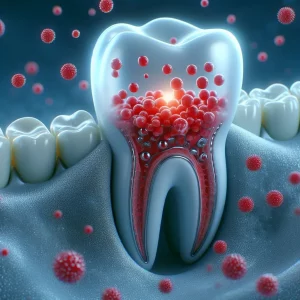Tooth Stem Cell: Storing stem cell from teeth is possibly the easiest way of accessing stem cell in contrast to adipose tissue or bone marrow extraction. The tooth extracted during a routine dental procedure need no longer be simply thrown away but can provide a significant resource for regenerative medical treatments.
By storing your own stem cell the risk of rejection of transplant material during a stem cell treatment is much lower than if donor cells or tissues are used. Potent immuno-suppressant drugs are less likely to be needed and stem cell transplants and tissue grafts are likely to have a more positive outcome.

Stem cell in the teeth have a very fast replication rate in comparison to other sources of stem cells in the body making them an excellent resource for rapid culture and treatment of acute conditions. By having the teeth already stored the waiting time that is normally required between stem cell harvesting and treatment is no longer necessary as the stem cells can be cultured in the laboratory and then transplanted in a single procedure.
Stem cells in teeth differ to those found in cord blood in that they can produce many types of cells; cord blood is a rich source of haematopoietic cells which can produce blood cells but not, necessarily, other cell types such as bone, vascular, or neural cells.
Storing Baby’s Milk Teeth
It is even more advantageous to store a child’s first teeth as they make way for their adult teeth due to the higher levels of activity and regenerative ability that younger stem cells possess. Whilst storing tooth stem cell from adult teeth is also possible, the tooth stem cell proliferation and differentiation rates are likely to be lower than in milk teeth which are multipotent. Multipotent stem cells, such as those found in bone marrow, and umbilical cord blood, are able to generate a number of different tissues such as cartilage, bone, skeletal muscle cells, heart tissue, and neural cells, meaning that they have a potentially huge number of applications in the treatment of disease (Miura, et. al., 2003).
Another advantage to storing babies’ milk teeth is that, as parents, the decision to store this material need not be made quickly. Unlike the storage of umbilical cord blood, which is a one-time only possibility, stem cells can be retrieved from all of a child’s milk teeth giving you a number of opportunities to invest in stem cell storage.
Many parents are choosing to do this for their older child after having their most recent child’s cord blood preserved. The large quantity of stem cells in the dental pulp and the amount of milk teeth that become available makes this previously discarded tissue extremely attractive in terms of the sheer number of stem cells it may provide.
The larger quantity of stem cells can mean that treatment options increase or can be conducted more quickly as technicians will not need to wait so long for a small number of stem cells to replicate before differentiation or implantation. In addition, the investment in storing teeth can be costly, and with each new tooth stored there are often discounted rates available from many companies.
How to Arrange Tooth Stem Cell Storage
There are numerous companies now offering tooth stem cell storage with some working in coordination with dentists and some providing access to the service directly to individuals. Your first move should be to discuss the possibility of storing extracted teeth (either yours or your child’s) with your dentist prior to any planned dental procedure.
You may find that they already have a relationship with a storage facility and have performed this service previously. If not, the onus is on you to investigate the myriad companies on offer, and to find out how much storage costs, what their terms and conditions are in case the stem cells recovered are not viable, and whether they operate in the area you live. Most companies have a policy of recrediting your money to your account if the stem cells recovered are not candidates for cryopreservation. This may mean that you (or another family member) can try again next time a tooth is ‘available’.
Your dentist will undergo simple training on how to recover and transport the tooth to optimize stem cell recovery and the procedure will not affect the level of care that you receive or require them to obtain any specialized equipment. The teeth will be collected and stored in such a way as to nourish the cells during transport to the laboratory and retain viability.
If they are viable then they will be cryopreserved for future use. Some of the more established companies, such as StemSave, have large storage facilities where other biological material, such as cord blood, unfertilized eggs, and sperm, are stored. Cryogenic preservation standards are high and these facilities are FDA-certified.
It is wise to investigate the accreditation of the company you are considering for storing tooth stem cell to ensure that they have similarly high standards. Provia Laboratories Inc.’s Store-A-Tooth are also a well-established company whose founders have been involved in the development of protocols for sample collection. Rather endearingly, the people at Store-A-Tooth have also developed a Tooth Fairy Gift Certificate programme to give youngsters a memento in place of the traditional coin under the pillow.
When Can I Use My Stored Tooth Stem Cell?
The possible applications for stem cell use continue to grow, with a number of clinical trials underway in the US and in Europe to investigate their ability to treat stroke, heart disease, and spinal cord injury. Other treatments, such as bone marrow transplants have been conducted successfully for many years, and stem cells are
also under investigation for their use as a base for growing complex tissues such as the replacement trachea successfully grown from stem cells and transplanted into a patient suffering from life-threatening respiratory pathology after tuberculosis. The potential for using stem cells recovered and stored from your teeth may be limited currently, but there are many applications routinely available and more likely to become available in the near future. If you are storing your child’s teeth then the possibility that they will use the stem cells during their lifetime are even greater as medical science advances.
Any Drawbacks to Tooth Stem Cell Storage
As always, with stem cell storage from any source, the main drawbacks from storing tooth stem cell are the costs involved and the potential for them to never actually be used. Processing costs can range from $500-1500 for an initial tooth to be stored, with a 15% or so discount on subsequent storage.
This is not the only cost however, as most facilities have fees of around $120 each year to cover storage costs. For many families this is prohibitively expensive, especially if they are considering having the company store teeth from each of their children and, possibly, themselves as well. Discounted longer-term rates are offered to cover storage for twenty years or so, and companies may also give incentives such as reductions if you refer a friend or fellow parent.
As with cord blood banking, there is a possibility that you or your child will never be in need of the stem cells saved in this fashion, or that scientific advancements will not come early enough to provide such treatment at the time it is needed. Newer techniques in stem cell extraction are also being developed such as autologous tooth stem cell harvesting from adipose tissue and skin.
Although these techniques are currently invasive and considerably more involved than simply storing a tooth that was to be removed anyway, they do offer a glimpse of a future where stem cells can be obtained, cultured, and reinserted into tissue much more simply and easily than is currently possible.
If you can afford the cost of tooth stem cell storage from teeth then it appears advantageous, and with no currently available public tooth stem cell banks (similar to public cord blood banks) privately investing in this technology may be a luxury you can’t afford to miss.
